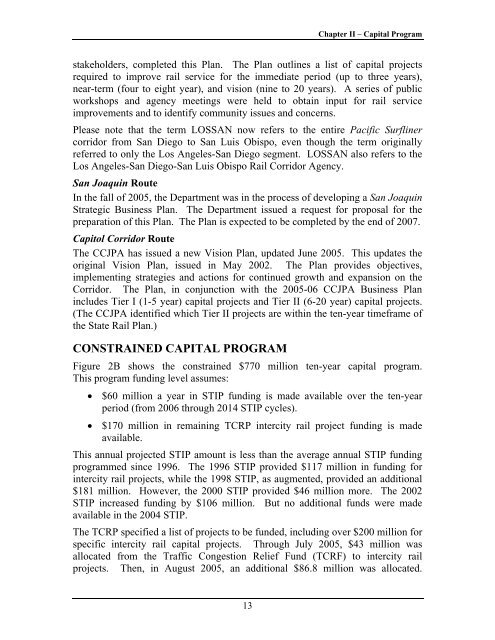California State Rail Plan 2005-06 to 2015-16
California State Rail Plan 2005-06 to 2015-16
California State Rail Plan 2005-06 to 2015-16
You also want an ePaper? Increase the reach of your titles
YUMPU automatically turns print PDFs into web optimized ePapers that Google loves.
Chapter II – Capital Program<br />
stakeholders, completed this <strong>Plan</strong>. The <strong>Plan</strong> outlines a list of capital projects<br />
required <strong>to</strong> improve rail service for the immediate period (up <strong>to</strong> three years),<br />
near-term (four <strong>to</strong> eight year), and vision (nine <strong>to</strong> 20 years). A series of public<br />
workshops and agency meetings were held <strong>to</strong> obtain input for rail service<br />
improvements and <strong>to</strong> identify community issues and concerns.<br />
Please note that the term LOSSAN now refers <strong>to</strong> the entire Pacific Surfliner<br />
corridor from San Diego <strong>to</strong> San Luis Obispo, even though the term originally<br />
referred <strong>to</strong> only the Los Angeles-San Diego segment. LOSSAN also refers <strong>to</strong> the<br />
Los Angeles-San Diego-San Luis Obispo <strong>Rail</strong> Corridor Agency.<br />
San Joaquin Route<br />
In the fall of <strong>2005</strong>, the Department was in the process of developing a San Joaquin<br />
Strategic Business <strong>Plan</strong>. The Department issued a request for proposal for the<br />
preparation of this <strong>Plan</strong>. The <strong>Plan</strong> is expected <strong>to</strong> be completed by the end of 2007.<br />
Capi<strong>to</strong>l Corridor Route<br />
The CCJPA has issued a new Vision <strong>Plan</strong>, updated June <strong>2005</strong>. This updates the<br />
original Vision <strong>Plan</strong>, issued in May 2002. The <strong>Plan</strong> provides objectives,<br />
implementing strategies and actions for continued growth and expansion on the<br />
Corridor. The <strong>Plan</strong>, in conjunction with the <strong>2005</strong>-<strong>06</strong> CCJPA Business <strong>Plan</strong><br />
includes Tier I (1-5 year) capital projects and Tier II (6-20 year) capital projects.<br />
(The CCJPA identified which Tier II projects are within the ten-year timeframe of<br />
the <strong>State</strong> <strong>Rail</strong> <strong>Plan</strong>.)<br />
CONSTRAINED CAPITAL PROGRAM<br />
Figure 2B shows the constrained $770 million ten-year capital program.<br />
This program funding level assumes:<br />
• $60 million a year in STIP funding is made available over the ten-year<br />
period (from 20<strong>06</strong> through 2014 STIP cycles).<br />
• $170 million in remaining TCRP intercity rail project funding is made<br />
available.<br />
This annual projected STIP amount is less than the average annual STIP funding<br />
programmed since 1996. The 1996 STIP provided $117 million in funding for<br />
intercity rail projects, while the 1998 STIP, as augmented, provided an additional<br />
$181 million. However, the 2000 STIP provided $46 million more. The 2002<br />
STIP increased funding by $1<strong>06</strong> million. But no additional funds were made<br />
available in the 2004 STIP.<br />
The TCRP specified a list of projects <strong>to</strong> be funded, including over $200 million for<br />
specific intercity rail capital projects. Through July <strong>2005</strong>, $43 million was<br />
allocated from the Traffic Congestion Relief Fund (TCRF) <strong>to</strong> intercity rail<br />
projects. Then, in August <strong>2005</strong>, an additional $86.8 million was allocated.<br />
13













